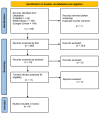Effectiveness of Prebiotics and Mediterranean and Plant-Based Diet on Gut Microbiota and Glycemic Control in Patients with Prediabetes or Type 2 Diabetes: A Systematic Review and Meta-Analysis
- PMID: 39408238
- PMCID: PMC11478454
- DOI: 10.3390/nu16193272
Effectiveness of Prebiotics and Mediterranean and Plant-Based Diet on Gut Microbiota and Glycemic Control in Patients with Prediabetes or Type 2 Diabetes: A Systematic Review and Meta-Analysis
Abstract
Background: A high-calorie diet results in the development of prediabetes (PD) or type 2 diabetes mellitus (T2DM). This diet has been reported to cause changes in microbial composition, concentration levels of glycemic parameters, and immune cells or inflammatory cytokines. This systematic review and meta-analysis aimed to evaluate the effects of prebiotics, as well as Mediterranean and plant-based dietary interventions, on gut microbiota composition and glucose homeostasis in individuals with PD or T2D.
Methods: This systematic review and meta-analysis was developed according to the 2020 PRISMA guidelines and checklist. PubMed, EBSCOhost and Google Scholar were the three databases that were used to search for electronically published studies. Data extraction was conducted and examined by the reviewers and all the eligible studies were selected. To test for the quality and biases of the included studies, the Downs and Black checklist was used, followed by the use of Review Manager 5.4. A forest plot was used for meta-analysis and sensitivity analysis. The strength of the evidence was assessed using the Grading of Recommendation Assessment, Development and Evaluation approach.
Results: Overall, eight studies met the inclusion criteria: seven focused on patients with T2D, and one focused on patients with PD. The prebiotic dietary intervention did not have a statistically significant effect on glycemic control, including fasting blood glucose (FBG) and glycated hemoglobin (HbA1c). However, one study investigating the Mediterranean diet reported a significant effect on glycemic control. Both prebiotic and Mediterranean dietary interventions were found to beneficially influence gut microbial composition in the intervention groups compared to the placebo groups. No studies assessed the impact of a plant-based diet on microbial composition and glucose parameters.
Conclusions: This review indicated that dietary intervention with a prebiotic or Mediterranean diet shows to beneficially improve the gut microbiota composition of Firmicutes, Bacteroidetes and Bifidobacteria in patients with PD or T2D. However, their beneficial effects on FBG and HbA1c were less clear and uncertain due to limited reports, particularly regarding the Mediterranean dietary intervention.
Keywords: Mediterranean diet; fasting blood glucose; glycated hemoglobin; glycemic control; gut microbiota; plant-based diet; prebiotics; prediabetes; type 2 diabetes.
Conflict of interest statement
The authors declare no conflicts of interest.
Figures




References
-
- Sun H., Saeedi P., Karuranga S., Pinkepank M., Ogurtsova K., Duncan B.B., Stein C., Basit A., Chan J.C., Mbanya J.C., et al. IDF Diabetes Atlas: Global, regional and country-level diabetes prevalence estimates for 2021 and projections for 2045. Diabetes Res. Clin. Pract. 2022;183:109119. doi: 10.1016/j.diabres.2021.109119. - DOI - PMC - PubMed
-
- World Health Organization . Definition and Diagnosis of Diabetes Mellitus and Intermediate Hyperglycaemia: Report of a WHO/IDF Consultation. World Health Organization; Geneva, Switzerland: 2006.
Publication types
MeSH terms
Substances
LinkOut - more resources
Full Text Sources
Medical
Miscellaneous

